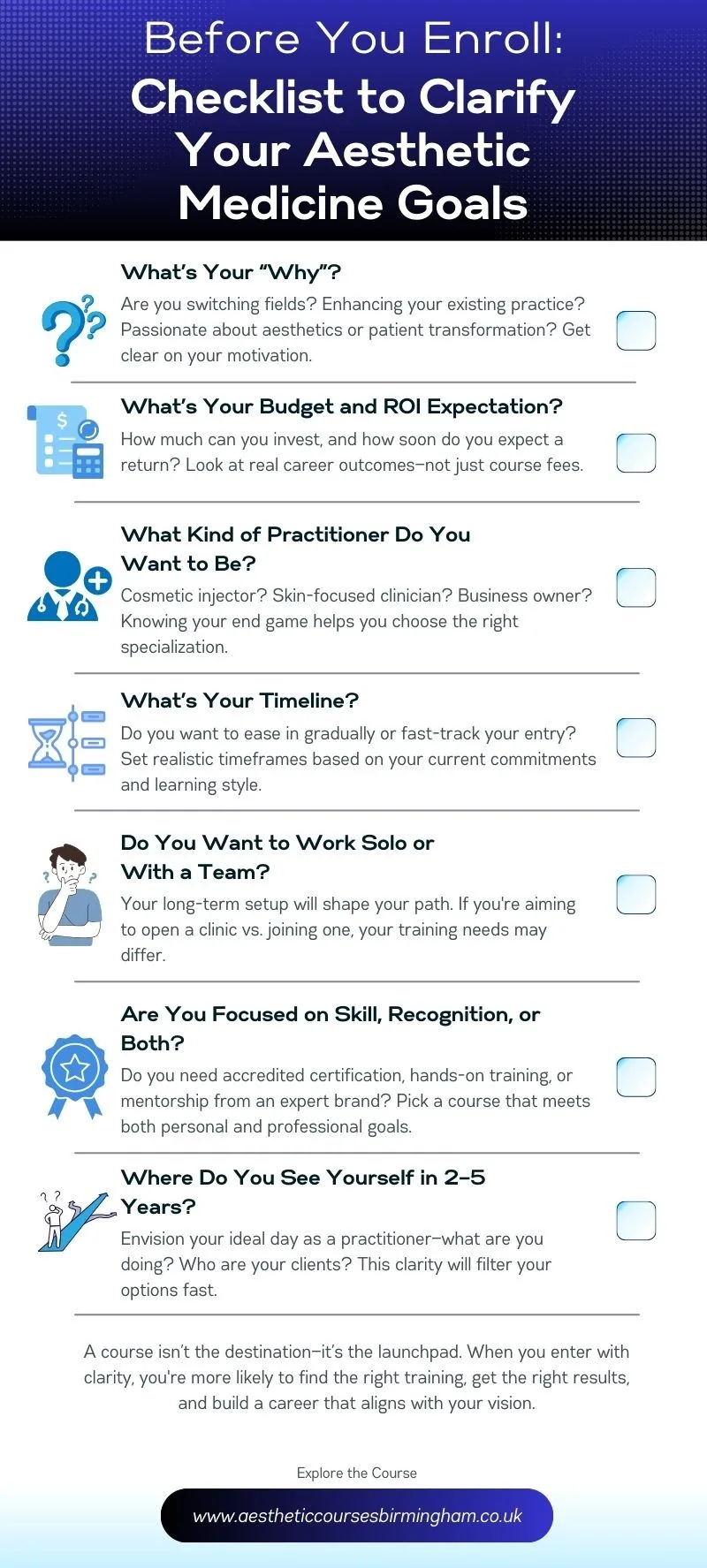
The world of aesthetic medicine is booming—and with it, the demand for skilled, confident practitioners. If you’re thinking about enrolling in a course, you’re not alone.
But before you dive in, it’s worth hitting pause. Not all programs are created equal, and what looks impressive on paper may not give you the hands-on skills, mentorship, or credibility you need. This guide cuts through the gloss to help you choose the right course—the one that aligns with your goals, values, and future in aesthetics.
Key Takeaways
- Aesthetic medicine courses vary widely, so research different types to find what suits you best.
- Accreditation is important; ensure your chosen course is recognised by relevant professional bodies.
- Hands-on training is essential; look for courses that offer practical experience.
- Understand the legal requirements and insurance needs before starting your practise.
- Stay updated on trends in aesthetic medicine to enhance your career opportunities.
Understanding Aesthetic Medicine Courses
What Are Aesthetic Medicine Courses?
Aesthetic medicine courses are designed to give medical professionals the skills and knowledge they need to perform cosmetic procedures safely and effectively. We’re talking everything from Botox and fillers to laser treatments and skin rejuvenation.
The goal is to equip you with the theoretical understanding and practical skills to meet the increasing demand for aesthetic treatments.
Types of Aesthetic Medicine Courses
There’s a whole range of courses out there, and it can be a bit overwhelming. You’ve got your introductory courses, which are great if you’re just dipping your toes in the water. These usually cover the basics of injectables like Botox and dermal fillers.
Then there are the more in-depth courses, like Level 7 aesthetic practice, which are aimed at those who want a more advanced qualification. And don’t forget specialist courses focusing on specific areas like laser therapy or skin care. It really depends on what you want to specialise in.
For example:
- Foundation Training in Botox & Dermal Fillers: A quick start for injectables.
- The Aesthetics Accelerator: Ideal if you want to get started quickly.
- Level 4 Certificate in Anatomy and Physiology for Aesthetic Practise: A deep dive into the body’s structure.
Importance of Accreditation in Aesthetic Training
Accreditation is super important. It means the course has been vetted by a professional body and meets certain standards. Why does that matter?
Well, an accredited course is more likely to give you a solid education, and it’s often a requirement for insurance and working in certain clinics. Plus, it shows potential employers (or your future patients) that you’ve received quality training. Think of it as a quality stamp.
Choosing an accredited course is not just about ticking a box; it’s about investing in your future and ensuring you’re providing the best possible care to your patients. It demonstrates a commitment to excellence and patient safety, which is what aesthetic medicine is all about.
Choosing the Right Course for Your Career
Choosing the right aesthetic medicine course is a big deal. It’s like picking the right tool for a job – get it wrong, and things could get messy. It’s not just about ticking boxes; it’s about setting yourself up for a successful and fulfilling career.
So, let’s break down how to make the best choice.
Identifying Your Career Goals
First things first, what do you actually want to do?
- Do you see yourself specialising in injectables, laser treatments, or maybe a bit of everything?
- Are you aiming to open your own clinic, or would you rather work in an established practise?
Knowing your end goal is key to choosing the right course. Think about the specific procedures you’re interested in and the type of clients you want to work with. This will help you narrow down your options and focus on courses that align with your aspirations.
Evaluating Course Content and Structure
Right, so you know what you want. Now, let’s look at what the courses actually offer. A good course should cover both the theory and the practical side of things. Check the curriculum carefully.
- Does it include anatomy, complications management, and the latest techniques?
- What about hands-on training with live models? That’s non-negotiable, in my opinion.
Also, consider the teaching methods. Is it all lectures, or are there workshops and case studies? The more interactive, the better.
Considering Course Duration and Flexibility
Time is precious.
- How long is the course, and how is it structured?
- Can you fit it around your current work or family commitments?
Some courses are full-time, others are part-time or online. Think about what works best for you. A short, introductory course might be good if you’re not sure about aesthetics, but a more in-depth course is better if you’re serious about it. Remember, this is an investment in your future, so don’t rush it.
Choosing the right course is a big step, but it’s also an exciting one. Take your time, do your research, and don’t be afraid to ask questions. With the right training, you’ll be well on your way to a rewarding career in aesthetic medicine.
Legal and Professional Requirements

Understanding Legal Obligations
Basically, you need to know what you’re allowed to do, and what you’re not.
Right now, the UK has pretty relaxed rules for non-surgical aesthetic treatments. This means that, unlike many other medical fields, there isn’t a strict legal requirement for specific training or qualifications to perform injectables.
Yes, you read that right – technically, someone with minimal training could start injecting. This is why choosing a reputable and accredited course is so important – it’s about patient safety, not just ticking boxes.
Insurance and Liability Considerations
You absolutely must have appropriate insurance that covers the full scope of your aesthetic practise. No ifs, no buts. This isn’t just about protecting yourself; it’s about protecting your patients. If something goes wrong – and let’s be honest, sometimes things do – you need to be covered.
Think about it:
- What happens if a patient has an allergic reaction?
- What if there’s a complication from a procedure?
- What if a patient isn’t happy with the results and makes a claim?
Your insurance needs to cover all these scenarios. It’s also worth checking the small print to make sure you’re covered for the specific treatments you’ll be offering. Public liability insurance is also a must, covering you if someone is injured on your premises. Don’t skimp on this – it could save you a fortune (and a lot of stress) in the long run.
Professional Regulatory Bodies and Their Roles
If you’re already a healthcare professional – a doctor, nurse, dentist, or pharmacist – you’ll also be accountable to your professional regulatory body. This means adhering to their code of conduct and ethical guidelines, which often have specific sections relating to aesthetic practise.
These bodies – like the General Medical Council (GMC), the Nursing and Midwifery Council (NMC), and the General Dental Council (GDC) – hold their members to a higher standard. They can investigate complaints, and if you’re found to have acted unprofessionally or negligently, you could face disciplinary action, including being struck off the register.
Even if you’re not a registered healthcare professional, it’s worth considering joining a professional association for aesthetic practitioners. These associations often have their own codes of conduct and standards of practise, and membership can demonstrate your commitment to professionalism and patient safety.
Plus, they often offer access to training, resources, and networking opportunities. It’s all about showing you’re serious about doing things the right way.
Practical Experience and Skill Development
Importance of Hands-On Training
You know your hyaluronic acid from your botulinum toxin. But let’s be real, reading about injecting and actually injecting are worlds apart. Hands-on training is absolutely vital; it’s where the rubber meets the road, or, perhaps more accurately, where the needle meets the skin. You need to get comfortable with the feel of different tissues, the resistance of the needle, and how your patient reacts.
Look for courses that offer plenty of practical experience with live models. Seriously, don’t skimp on this. It’s better to make mistakes in a controlled training environment than on a paying client.
Finding Mentorship Opportunities
Once you’ve completed your initial training, finding a mentor can be a game-changer. A good mentor can provide guidance, support, and help you navigate the complexities of the aesthetic medicine world. They can offer advice on everything from treatment planning to managing complications.
How do you find one? Start by networking. Attend industry events, join professional associations, and reach out to experienced practitioners in your area. Don’t be afraid to ask if they’d be willing to mentor you. Even shadowing someone for a few days can be incredibly beneficial.
Mentorship isn’t just about learning technical skills; it’s also about developing your professional judgement and building confidence. A mentor can help you identify your strengths and weaknesses, and provide constructive feedback to help you improve.
Building a Portfolio of Work
In the aesthetic medicine world, seeing is believing. A strong portfolio is one of your best assets. It showcases your skills, experience, and the results you can achieve. Start building your portfolio from day one. Take before-and-after photos of your patients (with their consent, of course!), and document your treatment plans and techniques.
Here are some things to include in your portfolio:
- Before-and-after photos (high-quality and well-lit)
- Case studies (detailing treatment plans and outcomes)
- Certificates and qualifications
- Patient testimonials (with consent)
Your portfolio is a living document that should evolve as you gain more experience. Keep it updated with your latest and greatest work, and use it to showcase your unique skills and style.
Future Trends in Aesthetic Medicine
Emerging Technologies and Techniques
So, what’s next for aesthetic medicine? Well, it’s all about new tech and techniques. Think about things like advances in energy-based devices (lasers, radiofrequency), improvements in injectables, and the rise of regenerative medicine.
We’re talking about treatments that are becoming more precise, less invasive, and offering longer-lasting results. It’s a pretty exciting time to be involved in this field, honestly.
- AI-driven diagnostics: Imagine software that can analyse skin conditions with incredible accuracy, helping practitioners tailor treatments perfectly.
- 3D printing: Customised implants and skincare products? It’s closer than you think.
- Gene therapy: Okay, this is further down the line, but the potential to target ageing at a genetic level is mind-blowing.
The Growing Demand for Aesthetic Treatments
Let’s face it, people aren’t going to stop wanting to look and feel their best. The demand for aesthetic treatments is only going to increase. Social media plays a big part, sure, but it’s also about a growing awareness of what’s possible and a greater acceptance of these procedures.
This means more opportunities for skilled practitioners. The key is to stay ahead of the curve and offer the treatments that people actually want.
The normalisation of aesthetic procedures is a big deal. It’s not just for the rich and famous anymore; it’s for everyone. This shift in attitude is driving the market and creating a more diverse clientele.
Career Opportunities in Aesthetic Medicine
With the industry booming, there are loads of different career paths you can take. You could work in a clinic, open your own practise, specialise in a particular area (like skin rejuvenation or injectables), or even get involved in research and development.
Flexibility is a big draw for many. Plus, the earning potential is pretty good too.
Financial Considerations for Aspiring Practitioners
Embarking on a career in aesthetic medicine is exciting, but it’s important to be realistic about the financial side of things. Let’s break down the key money-related aspects you’ll need to consider.
Tuition Fees and Funding Options
First up, the courses themselves. Aesthetic medicine courses can vary significantly in price, depending on the level, specialisation, and provider. It’s not unusual to see fees ranging from a few thousand to tens of thousands of pounds.
So, how do you pay for it all? Well, here are a few ideas:
- Self-funding: If you’ve got savings, this might be an option.
- Career Development Loans: These are specifically designed to help with career-related training.
- Payment Plans: Some course providers offer payment plans to spread the cost.
- Sponsorship: It’s a long shot, but some clinics might sponsor employees for further training.
Potential Earnings in Aesthetic Medicine
Okay, let’s talk about the good stuff – how much can you actually earn? The honest answer is, it varies a lot. Factors that influence your income include:
- Experience: Naturally, the more experienced you are, the more you can charge.
- Location: Big cities often command higher prices.
- Specialisation: Certain in-demand treatments can bring in more money.
- Employment Model: Are you employed, self-employed, or running your own clinic?
It’s worth doing some research to get a realistic idea of earning potential in your area. Don’t be afraid to talk to practitioners and ask for their insights.
Cost of Setting Up Your Practise
So, you’ve got your qualifications, and you’re ready to go solo. Great! But setting up your own practise comes with significant costs.
Here’s a quick rundown:
- Premises: Renting or buying a suitable space is a big one.
- Equipment: Lasers, treatment beds, and other equipment can be expensive.
- Insurance: Essential for protecting yourself and your business.
- Marketing: Getting the word out there costs money.
- Consumables: Fillers, Botox, and other supplies need to be factored in.
It’s easy to underestimate these costs, so create a detailed business plan and budget. Consider starting small, perhaps by renting a room in an existing clinic, to minimise initial outlay. Remember, building a successful aesthetic practise takes time and careful financial management.
Networking and Community in Aesthetic Medicine
Joining Professional Associations
Getting involved with professional associations is a really good move. It’s not just about adding another line to your CV; it’s about connecting with people who are as into aesthetic medicine as you are. Think of it as finding your tribe.
These associations often run workshops, provide resources, and keep you in the loop about what’s new in the field. Plus, being a member can boost your credibility – always a good thing.
Attending Industry Conferences
Industry conferences might seem a bit daunting, especially when you’re starting out, but honestly, they’re goldmines. It’s where you can learn about the latest techniques, hear from the experts, and, most importantly, network.
You get to meet people face-to-face, swap stories, and build relationships that can really help your career. Plus, many conferences have sessions specifically for those new to the field, which can be super helpful.
Connecting with Peers and Mentors
Don’t underestimate the power of connecting with people who are at a similar stage in their career, or those who’ve been there and done that. Peers can offer support, share experiences, and help you navigate the challenges of starting out.
Mentors, on the other hand, can provide guidance, share their expertise, and open doors to opportunities you might not have found on your own. It’s all about building a network of people you can learn from and grow with.
Finding a mentor can be a game-changer. Look for someone who’s not only skilled but also willing to share their knowledge and experience. It’s about finding someone who believes in you and can help you reach your full potential.
Conclusion
So, if you’re thinking about jumping into an aesthetic medicine course, take a moment to really weigh your options. It’s not just about the training; it’s about finding the right fit for you. Look for courses that suit your current skills and future goals. Remember, this field is all about continuous learning, so be prepared to keep up with new techniques and trends.
The demand for aesthetic treatments is growing, and with the right training, you can carve out a rewarding career. Don’t hesitate to reach out for more information or guidance. Your journey into aesthetic medicine could be the start of something truly fulfilling.
Frequently Asked Questions
What is an aesthetic medicine course?
An aesthetic medicine course teaches you how to perform cosmetic procedures, like Botox and fillers, to help improve people’s appearance.
What types of aesthetic medicine courses are available?
There are many types of courses, including beginner courses, advanced training, and specialised courses in laser treatments.
Why is it important to choose an accredited course?
Choosing an accredited course ensures that the training meets high standards, which is important for your career and patient safety.
What should I consider when selecting a course?
Think about your career goals, the course content, how long it lasts, and if it fits your schedule.
What legal requirements do I need to know?
You need to understand the laws around aesthetic practises, including insurance and what your professional body requires.
How can I gain practical experience in aesthetic medicine?
Look for hands-on training opportunities, find a mentor, or work in a clinic to practise your skills.







